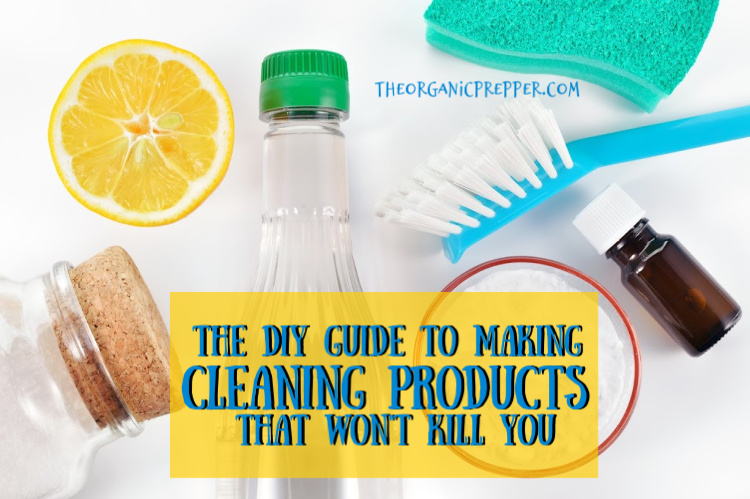If you're new here, you may want to subscribe to my RSS feed. Thanks for visiting!
Author of Be Ready for Anything and Bloom Where You’re Planted online course
Sometimes I really enjoy cleaning. I like to remove all the clutter, scrub all the surfaces, and open the windows for a fresh breeze.
However, what I don’t love is the expensive, chemical-laden cleaning products from the store.
Many of the chemicals that we are exposed to on a daily basis never leave our bodies, but accumulate in fat and bone marrow. There’s little oversight and testing on those chemicals. We’re living in a toxic civilization that seems sparkling clean and sanitary, but is actually poisoning us.
Cleaning products are rife with corrosive substances, irritating artificial fragrances, and petrochemicals. They can cause immediate symptoms like skin irritation, respiratory issues, allergic reactions, and eye irritation. Even worse, they can cause long-term issues like hormone disruption, brain cell death, permanent lung damage, and cancer. (You can learn more about the potential dangers of cleaning products in this article.)
It’s quick, frugal, and easy to make non-toxic cleaning products.
That’s why I spend just a few moments of extra time making my own cleaning products, from simple, non-toxic ingredients. I order most of my basic supplies online in bulk and keep them on hand so I can always whip them up as needed. Not only are you sparing your health, but you’ll save a lot of money with DIY products!
Here’s what you need for a clean home:
- Baking Soda (Save lots of money by buying it in bulk
)
- Borax
- White Vinegar
- Essential oils in your favorite scents
- Dr. Bronner’s liquid Castille soap
in your favorite scent
- Non-smelly cooking oil (I get something inexpensive for this since we won’t be consuming it)
- Lemon or lime juice
You can make everything you need from those items.
5 DIY Household Cleaning Product Recipes
Now, with your bulk products and a few Mason jars for storing your concoctions, here are the recipes for making five commonly-used cleaning products.
Scouring powder:
- 1 part baking soda
- 1 part borax
- Essential oil of choice
In a Mason jar, mix the baking soda with the borax. Sprinkle in some essential oil. (I like citrus or mint smells for the fresh clean fragrance.) Combine the mixture well, and put it in a sunny windowsill for a week to let the powders absorb the scent of the oils. If you aren’t concerned about the fragrance you can use this right away.
Spray surface cleaner #1:
- 2 parts white vinegar
- 1 part water
- Essential oil of choice
Fill a spray bottle with white vinegar and water. Add your favorite essential oils to cover the vinegar smell. This works on non-wood surfaces and glass.
Spray wood surface cleaner #2:
This one is good for wood surfaces. Mix this up as you go along because the oil can go rancid.
- 3 parts unscented cooking oil
- 1 part vinegar
- Essential oil of choice
Yes, basically, it’s salad dressing. I like to add sandalwood essential oil to this because it’s…well, woody. Lots of folks use citrus oil to get that lemon fresh fragrance. Spray this on wooden furniture and work with the grain.
Hardwood floor cleaner:
Your hardwoods will gleam with this cleaner. If you use it on laminate it will be slippery. This is only for real wood floors.
- 16 parts hot water
- 1 part cooking oil
- 1/2 part lemon or lime juice
- Citrus essential oil
Non-wood floor cleaner:
- 16 parts hot water
- 1 part borax
- 1/2 part Dr. Bronner’s Castille soap
- A few drops of tea tree essential oil
- A few drops of other essential oil for fragrance
If your floor is particularly greasy you can replace half of the water with white vinegar.
Resources:
Dr. Bronner’s liquid Castille soap (We use this for personal care products as well)

















Daisy, Question on the cooking oil. Is it corn oil or canola oil ? I stopped using those a few years ago on the advice of my (SUPER GREAT) doctor.He’s very supportive of me going to a more natural(clean) diet IE: no gmo’s, grains, fruit, veggies, etc. rather than all the processed crap in the stores these days. Don’t know how I got lucky with him but he’s is fantastic. Now If I can just catch up with my DH , he’s losing weight but I’m still plodding along HA HA.
Why are essential oils crossed out? Because they’re optional?
Hi – I’m not seeing them as crossed out – generally when a link is crossed out it means the link is to a page that no longer exists.
These recipes are great! Can you use coconut oil in the mixes? I can usually find it cheaply at HomeGoods or Winco.
I don’t think coconut oil would work because it is a solid at room temperature. You need an oil that is going to always be liquid.